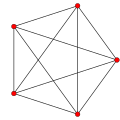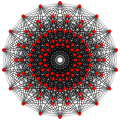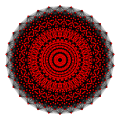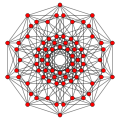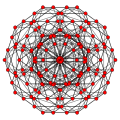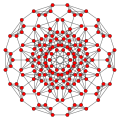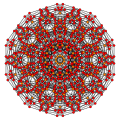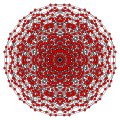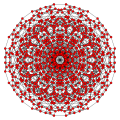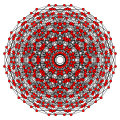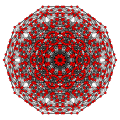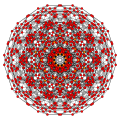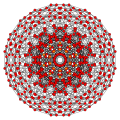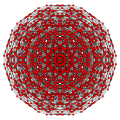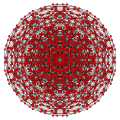Top Qs
Timeline
Chat
Perspective
5-orthoplex
Convex regular 5-polytope in geometry From Wikipedia, the free encyclopedia
Remove ads
In five-dimensional geometry, a 5-orthoplex, or 5-cross polytope, is a five-dimensional polytope with 10 vertices, 40 edges, 80 triangle faces, 80 tetrahedron cells, 32 5-cell 4-faces.
It has two constructed forms, the first being regular with Schläfli symbol {33,4}, and the second with alternately labeled (checkerboarded) facets, with Schläfli symbol {3,3,31,1} or Coxeter symbol 211.
It is a part of an infinite family of polytopes, called cross-polytopes or orthoplexes. The dual polytope is the 5-hypercube or 5-cube.
Remove ads
Alternate names
- Pentacross, derived from combining the family name cross polytope with pente for five (dimensions) in Greek.
- Triacontaditeron (or triacontakaiditeron) - as a 32-facetted 5-polytope (polyteron). Acronym: tac[1]
As a configuration
Summarize
Perspective
This configuration matrix represents the 5-orthoplex. The rows and columns correspond to vertices, edges, faces, cells and 4-faces. The diagonal numbers say how many of each element occur in the whole 5-orthoplex. The nondiagonal numbers say how many of the column's element occur in or at the row's element.[2][3]
Remove ads
Cartesian coordinates
Cartesian coordinates for the vertices of a 5-orthoplex, centered at the origin are
- (±1,0,0,0,0), (0,±1,0,0,0), (0,0,±1,0,0), (0,0,0,±1,0), (0,0,0,0,±1)
Construction
There are three Coxeter groups associated with the 5-orthoplex, one regular, dual of the penteract with the C5 or [4,3,3,3] Coxeter group, and a lower symmetry with two copies of 5-cell facets, alternating, with the D5 or [32,1,1] Coxeter group, and the final one as a dual 5-orthotope, called a 5-fusil which can have a variety of subsymmetries.
Remove ads
Other images
 The perspective projection (3D to 2D) of a stereographic projection (4D to 3D) of the Schlegel diagram (5D to 4D) of the 5-orthoplex. 10 sets of 4 edges form 10 circles in the 4D Schlegel diagram: two of these circles are straight lines in the stereographic projection because they contain the center of projection. |
Remove ads
Related polytopes and honeycombs
Summarize
Perspective
This polytope is one of 31 uniform 5-polytopes generated from the B5 Coxeter plane, including the regular 5-cube and 5-orthoplex.
Remove ads
References
External links
Wikiwand - on
Seamless Wikipedia browsing. On steroids.
Remove ads
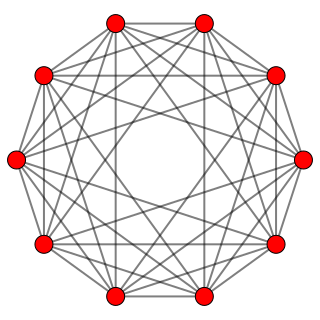








 ...
...

